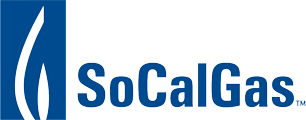With more than 40,000 students counting on their school buses to pick them up in the morning and take them home in the afternoon, the Los Angeles Unified School District (LAUSD) needs a clean, cost-efficient, reliable fuel supply. That’s why the nation’s second-largest school district turned to SoCalGas® to provide natural gas to fuel more than one-third of its entire school bus fleet.
LAUSD chose compressed natural gas (CNG) because it's clean-burning, inexpensive and reliable. With the largest fleet of CNG school buses in California, the district chose SoCalGas because it needed an expert partner to keep the tanks filled.
“It’s a good product, it’s good for the environment and it serves us well,” says Donald Wilkes, LAUSD’s transportation director.
Yellow School Buses Go Green!
With the help of SoCalGas, LAUSD launched a pilot program in the 1980s, starting with four CNG-fueled school buses. Over the years, the district also considered buses fueled with methanol, and later considered electric vehicles, but decided CNG was the best alternative fuel choice. Currently, 475 of the district’s school buses run on CNG.
"It’s a clean-burning fuel; you don’t have the fumes in your loading zones around school sites..."
“It’s a clean-burning fuel; you don’t have the fumes in your loading zones around school sites,” Wilkes says. “Anywhere we have kids and staff we want it to be as safe and healthful as possible.”
Wilkes knows how strong the fumes from diesel buses can be. The Southern California native drove a school bus in the 1980s. Hot days were a struggle between wanting to let air into the bus and fear that diesel fumes would seep in through the back windows. “The kids would complain. It’d be hot and they’d want to let the windows down and you’d have to deal with those fumes,” he recalls. “Moving to CNG, you don’t have that.”
The district began replacing many of its buses in the early 2000s. And in 2003, the school board passed a Healthy Breathing Initiative in an effort to green the district, including its buses. The initiative specified a preference for new CNG buses. Since then, the district has added two CNG fueling stations. Now parents notice fewer fumes at loading sites, and students learn the difference their own district can make for the environment.
By replacing hundreds of diesel buses with CNG-fueled vehicles, the district has reduced its greenhouse gas emissions by 2,595 metric tons, a 7.5 percent reduction just since 2007.
Incentives and Fuel Savings
LAUSD was able to use federal grants to pay most of the costs for its new CNG-fueled buses. The South Coast Air Quality Management District (SCAQMD) paid about 90 percent of the cost, Wilkes said. And the district pays far less for CNG than for diesel. “It’s a cheaper gas-gallon equivalent compared to gasoline or diesel fuel,” Wilkes says, estimating that the cost per mile is about 20 cents cheaper overall for CNG than it would be for diesel. “That can be substantial when you multiply that out by the number of buses we have.”
"From a budgeting perspective, you know what you’re going to pay. With gas and diesel, that can be uncertain."
Furthermore, the price of natural gas has remained stable. “It’s not prone to the price spikes that you see with gas and diesel,” Wilkes says. “From a budgeting perspective, you know what you’re going to pay. With gas and diesel, that can be uncertain.”
Another savings the school district has realized with CNG is the on-site, time-fill fueling system. Drivers park the buses in their stalls at the end of their shifts, connect the fueling system to the bus, leave it overnight and then disconnect it in the morning when the bus is fully fueled. The district gets the maximum mileage out of the bus each day and doesn’t have to pay the driver to wait for fueling. “It helps to cut costs,” Wilkes says.
LAUSD and SoCalGas
LAUSD is expert at getting its students to class on time. But for learning how to navigate the world of compressed natural gas, the massive district turned to SoCalGas and its account executives for the technical support and resources to fuel its buses.
When they entered into the relationship through CNG, SoCalGas account executives took the role of teacher, making sure LAUSD officials understood the transition process. “They’ve always been there” to answer questions, Wilkes says. “They initiated many meetings to make sure we understood everything. It’s been a very positive relationship.”
CNG: At the Head of the Class
Now that LAUSD has tested the transition process of changing much of its old diesel bus fleet to clean CNG, it gets calls from other school districts interested in switching. “I always get questions about our fleet,” Wilkes says. He cites the grants available from SCAQMD for buying the buses as a plus. And for districts in the SoCalGas service area, he says, the company’s reliability and knowledgeable staff make switching to CNG more feasible. “SoCalGas has come aboard as a partner to help deliver compressed natural gas,” Wilkes says. “If you can get help with that infrastructure, that’s a big piece of it.”
Wilkes sees manufacturers adding to the variety of buses made to run on CNG. And when they offer smaller buses as well as the larger ones fueled by CNG, he sees even more districts following LAUSD’s path. The district’s transportation director believes CNG will play an ever-more important role in the transportation needs of school districts. “CNG is still a better buy and just a better engine in regards to the environment” Wilkes says. “I do see growth in the CNG market as large fleet operators replace their vehicles. We’ve invested in CNG and we plan to stay with it.”
These case study materials are provided solely for information purposes, and are not a forecast or guaranty of any savings or results that will be obtained from using natural gas. A number of factors can influence actual results, including future gas prices, equipment used, actual usage and other operating conditions. Specifically, SoCalGas does not endorse or provide any warranty of fitness for any particular purpose or use of any equipment selected by customer.

